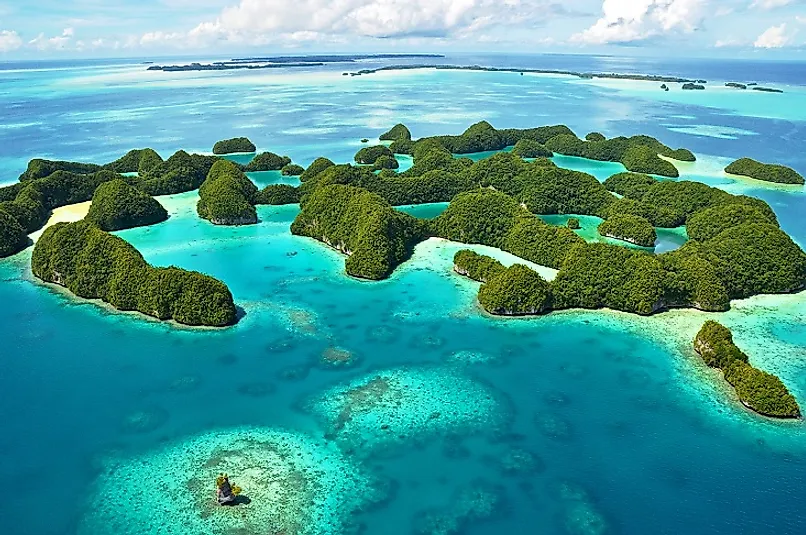Rock Islands Southern Lagoon, Palau

5. Description -
The Rock Islands of Palau are located in the Pacific Ocean where they make up a small part of Micronesia. Researchers estimate that Rock Islands consist of around 445 volcanic, coral limestone islands that have a total area of 18 square miles. The vast majority of this area is uninhabited. These islands were once coral reefs that broke the surface of the water. Today, the islands are a UNESCO World Heritage Site.
4. Climate and Geology -
The Rock Islands are uniquely shaped, the majority haven taken on mushroom-like forms, and appear to have their stems reaching into the waters. This form was created by volcanic activity which pushed the coral reefs above water thousands of years ago. Since then, wind, water, weather, and changing flora have continued to shape the islands. Similar to the rest of Palau, the Rock Islands enjoy a tropical climate with average temperatures around 82° Fahrenheit. Humidity runs high and precipitation totals approximately 150 inches per year. Rain is heaviest between July and October.
3. Tourism and Education -
Tourism to the Rock Islands has become popular among visitors from all around the world. Some common activities here include sea kayaking, snorkeling, and scuba diving. The Blue Corner, Blue Holes, and German Channel are popular dive spots and offer tourists the opportunity to swim around lagoons, underwater caves, and manta rays. One of the most interesting sites for tourists is Jellyfish Lake on the Eil Malk island. This lake is home to two species of jellyfish, namely the Golden Jellyfish and the Moon Jellyfish. The golden jellyfish migrates horizontally across the lake on a daily basis. Both species are unable to sting, making them safe for swimmers. Dolphin Bay is located at the southern end of the islands. Here, tourists can learn more regarding the lives of dolphins from the educators on staff.
2. Habitats and Biodiversity -
These islands are teeming with biodiversity. They are surrounded by a large reef system with over 385 types of coral species. Dugong, which belong to the same family as manatees, 13 species of sharks, 746 fish species, 7 giant clam species, and an endemic nautilus all make their homes off the coasts of the islands. Other habitats within the water include channels, caves, coves, and tunnels. Some of the most interesting habitats on these islands are its 52 marine lakes, the highest concentration found in the world. Marine lakes are bodies of seawater that have been separated from the ocean and are surrounded by land. Scientists have discovered that each of these lakes is in a unique stage of evolution and are home to high levels of endemic species. Five new Mastigias Papua jellyfish subspecies have been discovered here. Scientists utilize these lakes to learn more in regard to the development of marine ecosystems. The Rock Islands themselves are covered in forests which host endemic birds, mammals, reptiles, amphibians, and almost 50% of the endemic plant species of Palau.
1. Environmental Threats and Conservation Efforts -
As previously mentioned, the Rock Islands were inducted as a UNESCO World Heritage Site in 2012 in an effort to conserve the area's unique cultural and natural diversity. Koror State of Palau is responsible for managing the environmental regulations protecting the islands and all of the archaeological ruins are protected under the Historical and Cultural Preservation Act of the country. Because of its protected status, habitat degradation and overfishing are not of significant concern. However, the islands and the rest of Palau are threatened by rising sea levels. Flooding of coastal areas can disrupt the habitat there, negatively affecting its plant and animal life. According the the Intergovernmental Panel on Climate Change, rising sea levels are caused by increasing global temperatures which are, in turn, attributed to human activity.











